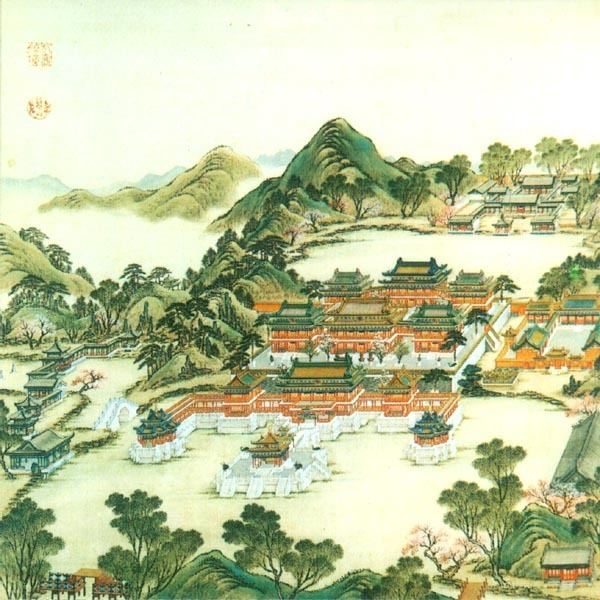 | ||
Sharawadgi or sharawaggi is a style of landscape gardening or architecture in which rigid lines and symmetry are avoided to give the scene an organic, naturalistic appearance. This concept was influential in English landscape gardening in the 18th century, starting with Sir William Temple's essay Upon the gardens of Epicurus, and reports from China of the Jesuit missionary, Father Attiret. Sir William Temple first used the word sharawadgi in discussing the Chinese idea of beauty without order in garden design, in contrast to the straight lines, regularity, and symmetries then popular in European gardens. The style indicates a certain irregularity in the design.
Contents
Sharawadgi was defined in the 1980s as an "artful irregularity in garden design and, more recently, in town planning". The word inspired the coinage of the term "Sharawadji Effect" by composer Claude Schryer, which is used in relation to music and the listening experience.
Etymology
The term sharawaggi (more frequently spelled sharawadgi) typically referred to the principle of planned naturalness of appearance in garden design. It was first used by Sir William Temple (1628–1699) in an essay, written in 1685 but published in 1692, "Upon the Gardens of Epicurus". Temple may have picked up the term from a Dutchman who once lived in the East Indies. Horace Walpole associates the term with irregularity, asymmetry, and freedom from the rigid conventions of classical design; by the time of it was used by Walpole it had become a common term in the lexicon of eighteenth-century aesthetic theory.
However, the original word for sharawadgi has been a matter of debate. Some had attempted to reconstruct a possible Chinese origin of the word, for example, "sa luo gui qi" (洒落瑰琦) meaning "quality of being impressive or surprising through careless or unorderly grace", another proposed san luan (散亂) or shu luo (疏落), both meaning "scattered and disorderly", in combination with wei zhi (位置, position and arrangement) to mean "space tastefully enlivened by disorder". After reviewing the suggestions, however, Susi Lang and Nikolaus Pevsner concluded that the word cannot be firmly established to be a Chinese term. Michael Sullivan suggested that it is a corruption of a Persian word, while a number of other scholars proposed a Japanese origin. Some thought that it originated from the Japanese term sorowaji (揃わじ), which means asymmetry, irregular. Another hypothesis is that it stems from the Japanese term shara'aji or share'aji (洒落味、しゃれ味), used to describe decorative motifs in works of applied art. Although there is no attested usage of shara'aji in the Edo period when the term was first borrowed into English, both its components shara and aji were common concepts in the era, and the concepts would have been used in tandem by craftsmen of the period. Shara has a number of possible meanings, including " open minded, but fully controlled, poetry composition", "witty in conversation" and its meaning may be extended to personal and showy adornments; while aji means "taste". The term shara'aji had been used a few times in literary criticism; and is still in common use for items such as kimonos.
History
Merchants from the Dutch East India Company may have brought the term to Europe at the end of the seventeenth century together with Edo period Japanese lacquer ware such as cabinets and screens that they imported from Japan. Sharawadgi as a term in written discourse was introduced in England by Sir William Temple in his essay Upon the Gardens of Epicurus. Temple was an English ambassador residing in The Hague and associating with the King and Queen.
He took the exotic, non-symmetric landscapes depicted on such imported artwork as supporting his personal preference for irregular landscape scenery. He had seen such irregularity in Dutch gardens where a discourse was on about naturalness in landscapes, planned or not. As a result of his introducing the term sharawadgi, Temple is considered to have been among those who introduced the basic ideas that led to the development of the English landscape garden movement.
Joseph Addison took up this discourse (1712), without direct reference to sharawadgi, at which time the original meaning got lost. In England the term reappears with Alexander Pope (1724) and Horace Walpole (1750), to be picked up again by Nikolaus Pevsner, who brought sharawadgi to the field of town planning.
Other meanings
Inspired by the original idea of more organic, naturally-led garden landscaping, the Sharawadji Effect (spelled with a j rather than a g) has been employed in music, using more natural, ambient soundscapes to create richer, more encompassing, and more realistic "soundscapes". Information on the origins of the Sharawadji Effect in music is not widely accessible, but scholars seem to agree on the definition that sharawadji is "An aesthetic effect that characterizes the feeling of plenitude that is sometimes created by the contemplation of a sound motif or a complex soundscape of inexplicable beauty." When the Chinese visit a garden that is beautiful because of its organic quality (in other words, its apparent lack of organized design), it is often said that its 'sharawadji' is admirable. In the same fashion, a musical piece employs the Sharawadji Effect if it has a less clean-cut, structural quality and overall a more naturally ambient sound.
In modern Japan, share'aji is a term used in kimono fashion where it refers to the taste of the design motifs featured in kimono dress, and the coordination of the sash obi with that of the kimono, and to the occasion of wearing them.
